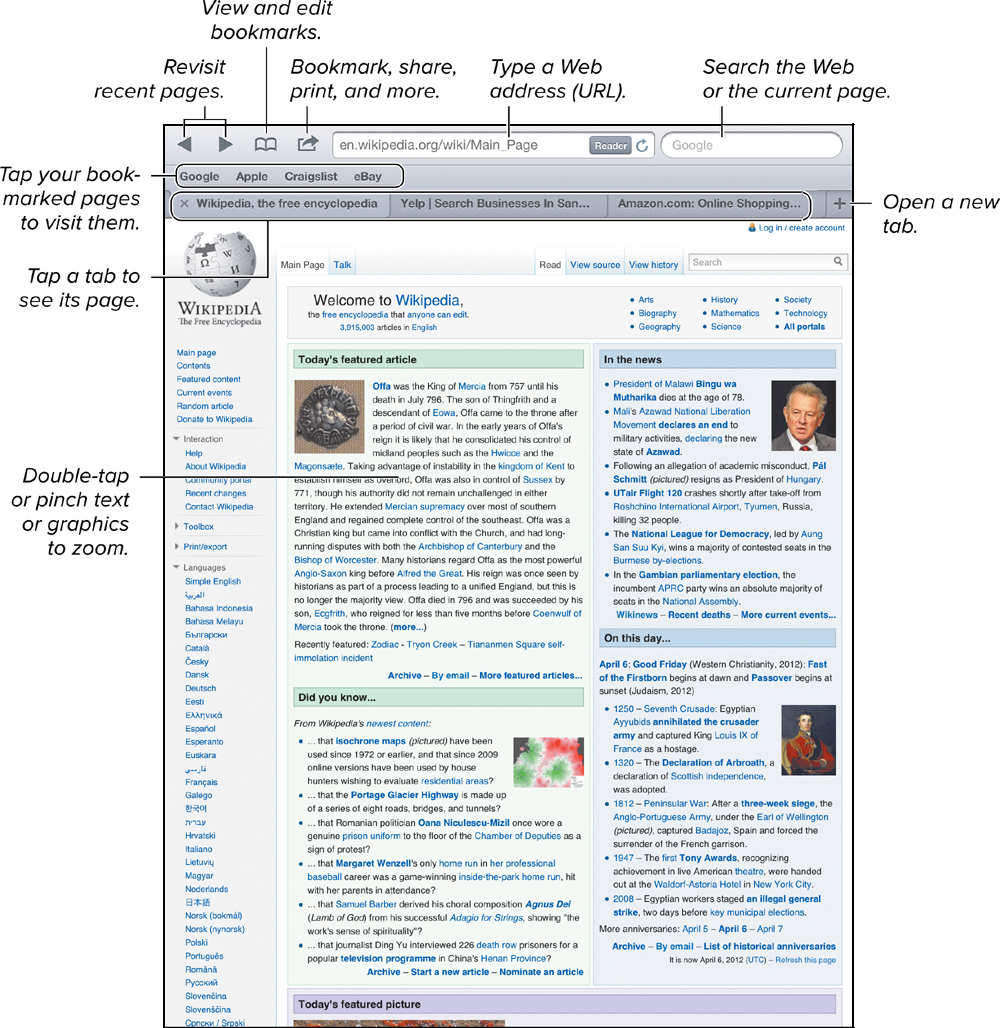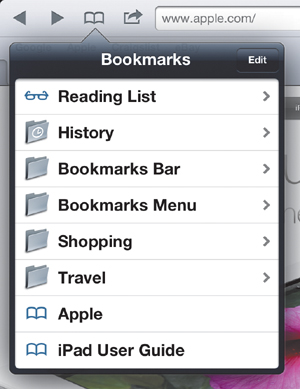21. Safari
In This Chapter
Managing Cookies, Privacy, and Security
 Safari is the iPad’s Web browser. You can use it to download files and to display Web pages with text, graphics, animations, sounds, video, and links—but not Adobe Flash media, which isn’t supported by iPad or other iDevices. Safari requires an Wi-Fi or cellular Internet connection.
Safari is the iPad’s Web browser. You can use it to download files and to display Web pages with text, graphics, animations, sounds, video, and links—but not Adobe Flash media, which isn’t supported by iPad or other iDevices. Safari requires an Wi-Fi or cellular Internet connection.
Note that the Web is a portion of the Internet. (The terms are not synonyms.) The Internet contains not only the Web, but also channels for email (see Chapter 13), instant messages (see Chapter 15), and more.
Browsing the Web
The important part of Safari is not the app itself, but the access it gives you to Web pages and other online resources. You’ll spend most of your browsing time working within the Web itself—reading, searching, scrolling, zooming, tapping links, filling out forms, downloading files, and so on—rather than using Safari’s controls ![]() .
.

![]() Safari and Web-site controls.
Safari and Web-site controls.
Like all modern browsers, Safari features tabbed browsing, which lets you open multiple Web pages on the same screen. You can open pages or links in new tabs and switch among them by tapping tabs. You can have up to nine tabs open at the same time.
To open a Web page
1. Tap the Safari icon on the Home screen.
The Safari screen appears, showing a blank page or the last page you had open during your previous browsing session.
2. To go to a specific Web page, tap the Address field, type or paste the address (URL), and then tap Go on the keyboard.
or
Tap one of the suggestions in the Address field’s drop-down list ![]() .
.

![]() As you type, Safari suggests matching addresses from your bookmarks and browsing history.
As you type, Safari suggests matching addresses from your bookmarks and browsing history.
Safari displays the Web page in the current tab.
Press and hold the .com key to get your choice of .net, .org, .edu, and other top-level domains, depending on what country or region you’ve set your iPad for.
To search the Web
1. Tap the Search field (labeled Google by default ![]() ).
).
2. Type or paste search keywords and then tap Search on the keyboard.
or
Tap one of the suggestions (from the search engine) in the Search field’s drop-down list.
Safari displays the search provider’s Web page, listing the search results ordered by relevance.
Navigating Web pages
You can do any of the following things when you navigate Web pages:
• Scroll and zoom. To scroll, flick or drag in any direction. To zoom in or out, double-tap, spread, or pinch. To scroll to the top of a page quickly (in most apps), tap the status bar at the top of the screen. To scroll within a frame (inset window) on a page, scroll with two fingers inside the frame.
• Rotate your iPad. You can view pages in either portrait (tall) or landscape (wide) view. Web pages scale automatically to the wider screen, making the text and images larger.
• Reload the page. To reload a stale or incomplete page, tap ![]() in the Address field
in the Address field ![]() .
.
• Stop downloading a page. If you request the wrong page or tire of waiting for a slow-loading page, tap ![]() in the Address field to stop the page from downloading any further.
in the Address field to stop the page from downloading any further.
• Revisit pages. To revisit pages that you’ve seen recently, tap or press and hold ![]() or
or ![]() . To revisit pages that you’ve seen in the past week or so, tap
. To revisit pages that you’ve seen in the past week or so, tap ![]() > History.
> History.
To view and manage tabs
• Do any of the following:
• To view a different tab, tap it.
• To open a new tab, tap ![]() on the tab bar.
on the tab bar.
• To reorder tabs, drag them left or right on the tab bar.
• To close a tab, tap the tab to activate it and then tap ![]() on the tab.
on the tab.
To search the current Web page
1. Type or paste text in the Search field ![]() .
.
2. Scroll to the bottom of the pop-up window and then tap the item below On This Page.
3. If multiple matches are found, tap ![]() or
or ![]() at the bottom of the screen to navigate among them.
at the bottom of the screen to navigate among them.
To share the current page
1. Tap ![]()
![]() .
.

![]() You can email, print, or tweet the Web address of the current page.
You can email, print, or tweet the Web address of the current page.
2. Choose an action from the drop-down list:
• Mail Link to This Page
• Tweet
Uncluttering pages
Safari’s Reader feature strips pages of ads, graphics, toolbars, and other nonessential elements, letting you read without distractions. To view an article in Reader, tap Reader in the Address field (if it appears; not every page works with Reader) ![]() . To adjust the font size, tap
. To adjust the font size, tap ![]() . To return to normal view, tap Reader again.
. To return to normal view, tap Reader again.

![]() Reader strips a page of distracting junk.
Reader strips a page of distracting junk.
Bookmarking Web Pages
You can bookmark Web pages that you like and open them quickly in the future. As your bookmarks list grows, you can organize your bookmarks in folders.
To bookmark the current page
• Tap ![]() > Add Bookmark.
> Add Bookmark.
To add a bookmark icon to the Home screen
• Tap ![]() > Add to Home Screen.
> Add to Home Screen.
To open a bookmarked page
1. Tap ![]() .
.
2. Tap the bookmark you want in the drop-down list ![]() .
.

![]() Bookmarks are normally saved at the top level of the Bookmarks list.
Bookmarks are normally saved at the top level of the Bookmarks list.
Editing and reordering bookmarks
Bookmarks placed in the Bookmarks Bar folder appear on the bookmarks bar, above the tabs. To reach bookmarks placed in other folders, you must tap ![]() . To edit, reorganize, or delete bookmarks, tap
. To edit, reorganize, or delete bookmarks, tap ![]() > Edit
> Edit ![]() and then drag or delete the bookmarks in the list.
and then drag or delete the bookmarks in the list.
The bookmarks bar appears when you tap the Address field. To always show it, tap Settings > Safari > Always Show Bookmarks Bar.
Syncing bookmarks
To sync bookmarks wirelessly across your computers and iDevices, tap Settings > iCloud > Bookmarks > On. (For details, see “Using iCloud” in Chapter 4.)
You can also sync bookmarks with the browser on your computer. (See “Syncing with iTunes” in Chapter 4.)
Working with Links
Text links typically are colored phrases. Pictures and buttons can also be links.
Navigating links
To follow a link, tap it. To see a link’s destination or open it in a new tab, touch and hold the link ![]() .
.

![]() Touch and hold a link to see where it leads; open it in the current tab; open it in a new tab; add it to your reading list; or copy its URL to the Clipboard.
Touch and hold a link to see where it leads; open it in the current tab; open it in a new tab; add it to your reading list; or copy its URL to the Clipboard.
To open new tabs behind the current tab, tap Settings > Safari > Open New Tabs in Background > On.
Saving links to read later
Safari’s Reading List feature lets you quickly save links to Web pages that you want to read later. You can think of the reading list as being a special, temporary bookmarks list.
To add the current page to your reading list
• Tap ![]() > Add to Reading List
> Add to Reading List ![]() .
.
To add a link to your reading list
1. Touch and hold the link.
2. Tap Add to Reading List ![]() .
.
To view your reading list
• Tap ![]() > Reading List.
> Reading List.
Safari divides the list into two parts: All and Unread.
To remove an item from your reading list
• Flick its entry and then tap Delete.
Managing Cookies, Privacy, and Security
Cookies are messages given to Safari by Web sites and stored on your iPad as small files. A cookie’s main purpose is to identify you and possibly prepare customized Web pages for you. When you enter shopping preferences and personal information at, say, Amazon.com, that information is stored in a cookie, which Amazon can read when you return.
Most cookies are innocuous and spare you from having to fill out forms repeatedly, but some sites and advertisers use tracking cookies to record your browsing history.
To control cookies and privacy settings
1. Tap Settings > Safari to open the Settings screen ![]() .
.

![]() Set your privacy preferences here.
Set your privacy preferences here.
2. Configure the privacy and security settings the way you want them.
To cover your tracks, clear your browsing history, cookies, and personal data. To hide from third-party advertisers, tap Accept Cookies > From Visited.
Autofilling Forms
Safari’s AutoFill feature automatically fills in your name, address, and other contact info on Web forms, saving you from typing the same information repeatedly. (AutoFill is especially useful for frequent online shoppers.) The feature can also memorize your user names and passwords—convenient, but a potential disaster if you ever lose an iPad that isn’t passcode-locked. (For details, see “Securing Your iPad in Chapter 1.)
To use AutoFill
1. Tap Settings > Safari > AutoFill ![]() .
.

![]() Activate AutoFill here.
Activate AutoFill here.
2. To make AutoFill enter your contact information on Web forms, turn on Use Contact Info.
3. To make AutoFill fill enter your user names and passwords on login screens, turn on Names and Passwords.
AutoFill memorizes your login credentials the first time you enter them after turning on this setting.
